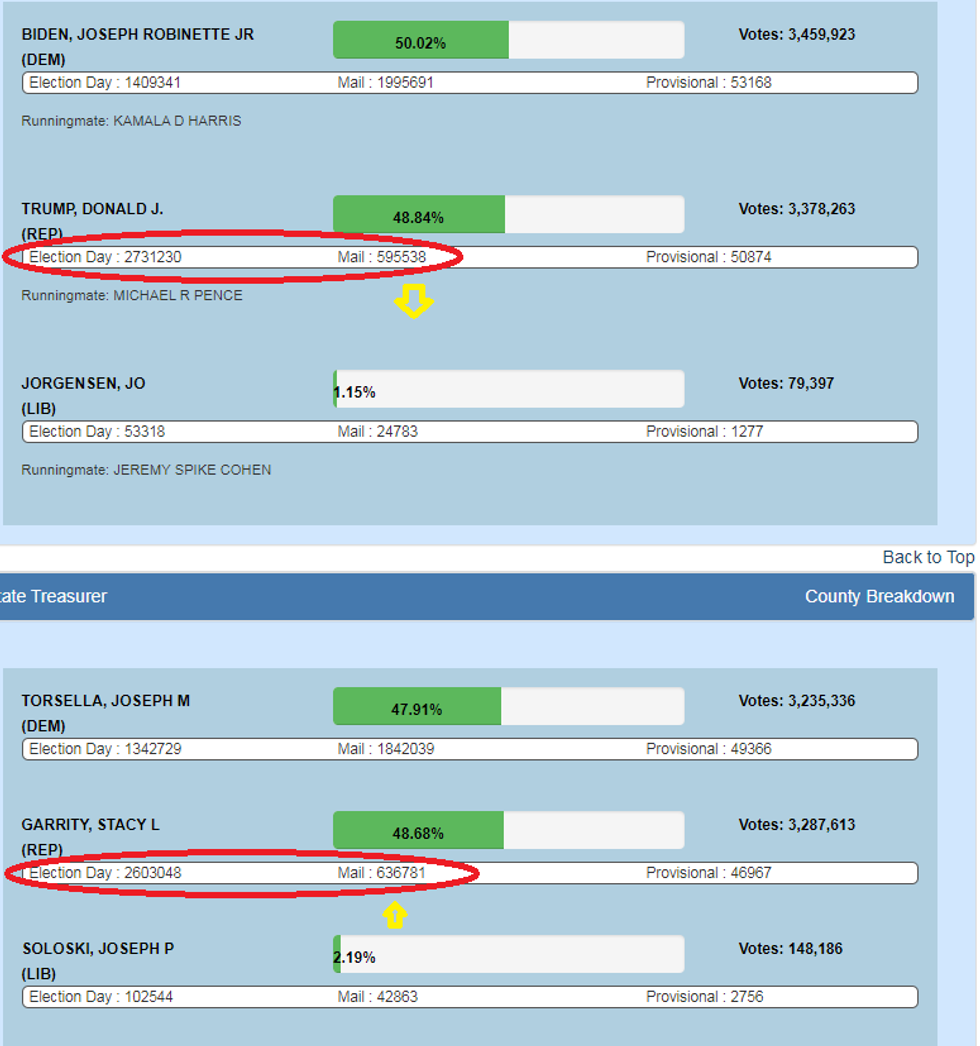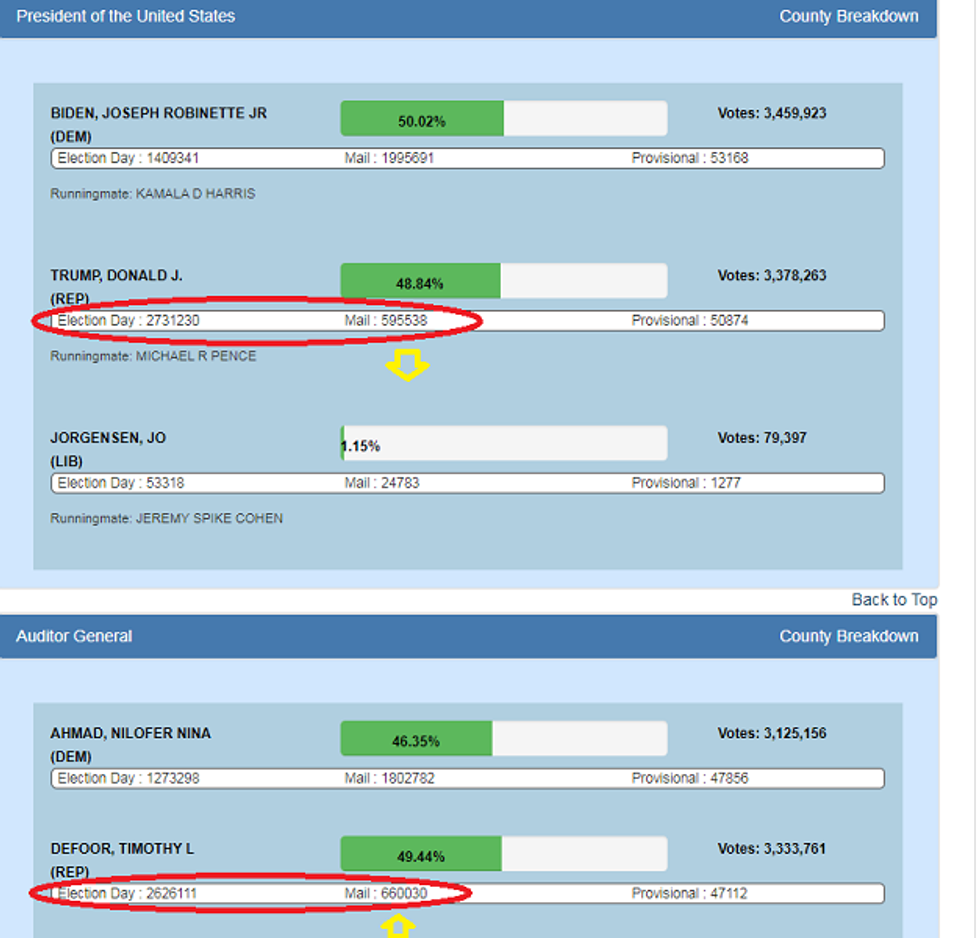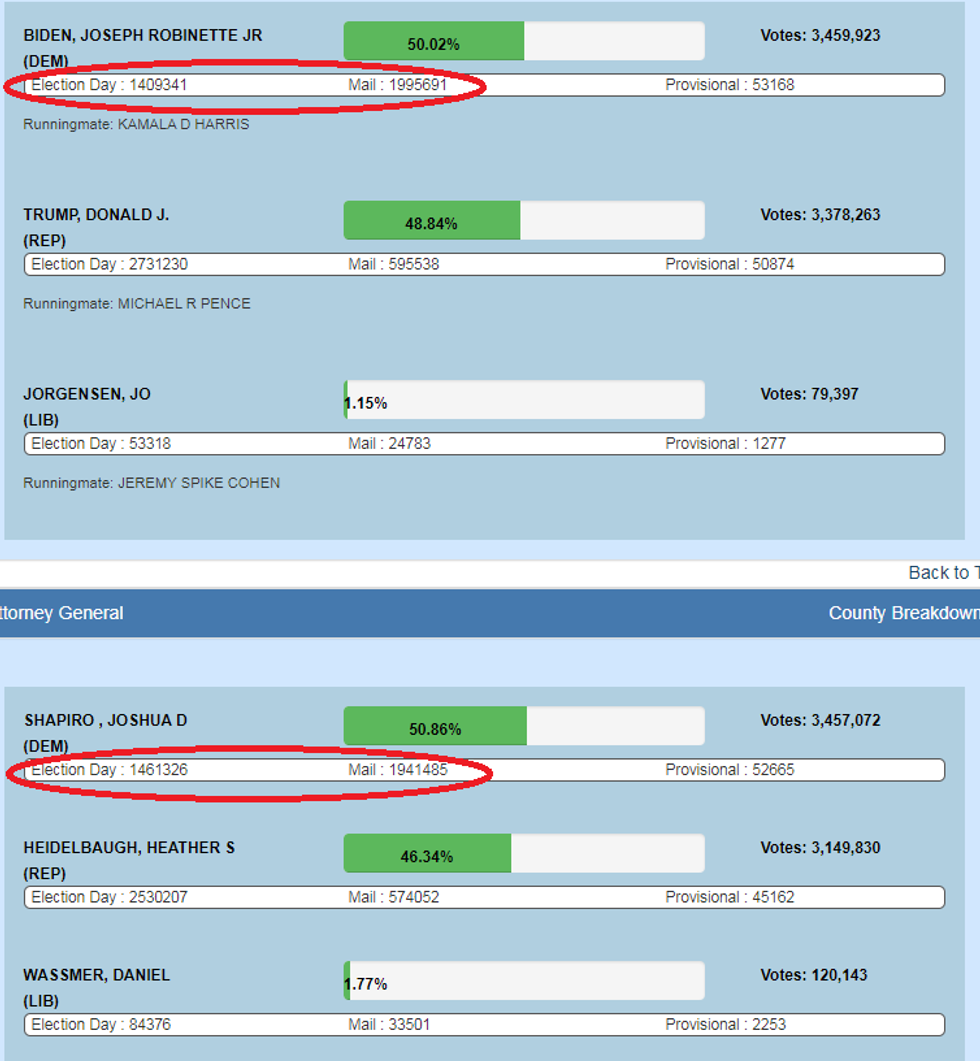
David Cliff/NurPhoto/Getty Images

Facts
There has been a lot of focus on the number of mail-in ballots counted in Pennsylvania and the illegal state Supreme Court decisions that enabled them. But what is even more important to examine is the impossible margins Joe Biden would have achieved just among those mail-in ballots and just in Pennsylvania in order to obtain the unofficial lead he currently has.
Here are the facts. We know that 2.6 million mail-in ballots have been counted in the Pennsylvania election returns, in addition to nearly 4.2 million Election Day votes. We also know from the secretary of state that Trump won Election Day votes, 2.7 million to 1.4 million. But we are to believe that Biden won 76% of mail-in ballots.
Yes, mail-ins overwhelmingly skewed Democrat, like Election Day votes skewed Republican, but they were not all from Democrats. We know that 64.7% of those votes were from registered Democrats, 23.7% from Republicans, and 11.6% from nonpartisan or other party voters.
What does this mean in simple arithmetic? My friend (who goes by screen name Gummi Bear on Twitter) crunched the numbers and showed that had Biden won 95% of returned Democrat mail-in votes, 21% of returned Republican votes, and 80% of returned independent votes, he would still have come up short of his margin of victory reported in the unofficial tally.
We know those numbers alone are absurd. There is no way Biden won 21% of mail-in ballots from registered Republicans in this state. Exit polls showed Biden getting just 8% of the GOP vote overall. While the 95% number for Democrat mail-ins is more believable (exits showed him getting 92%), the notion that 80% of mail-ins from independents went to Biden is nearly impossible. Exit polls showed Biden winning 52% of the vote of independents overall. It would defy logic to think that there was such a qualitative gap between the type of independents who came out on Election Day and those who voted by mail.
Assuming the mail-ins broke down in accordance with the exit polls, Biden would be down by 213K votes, even if every one of the 2.6 million mail-ins were truly valid and had proper matching signatures.
And speaking of signature validation, this statistical anomaly should lend a lot of suspicion to the already questionably low rejection rate of mail-in ballots this year. According to the 2016 Election Administration and Voting Survey, the rejection rate last election was just a tad under 1% in the Keystone State, even though there were only 266K mail-in ballots, which are mainly those who have experience filling out absentee ballots. This year, with 2.6 million mail-ins, consisting primarily of first-timers, we are to believe that just 0.038% were invalid?
Some estimates show that mail-in ballots from first-timers are three times more likely to be rejected. Yet we are to believe the acceptance rate this year was 27 times higher than in 2016?
Can you imagine what we would find if there was an attempt to audit and match all 2.6 million ballots for valid signatures and other information? Even Barack Obama, during his March 2008 primary with Hillary Clinton, raised concerns about the need to verify signatures on mail-in ballots.
FLASHBACK: Obama Cast Doubt On Mail-In Ballots, Praised Signature Verification (As Dems Sue To Ban)www.youtube.com
The sheer number of perfectly completed absentee ballots and the shockingly lopsided margins for Biden seem to lie beyond our willing suspension of disbelief on numerous fronts. For example, as state Sen. Mike Jones (R) explained at the hearing in Gettysburg last Wednesday, just an apples-to-apples comparison between Republican Election Day vs. Republican mail-in ballots and then Democrat Election Day vs. Democrat mail-in ballots reveals an extremely anomalous and contradictory trend in down-ballot races as compared to the presidential race.
While Trump supposedly lost at the top of the ticket, Republican Stacy Garrity beat incumbent Democrat Joseph Torsella in the race for state treasurer, even though she garnered 91,000 fewer votes than Trump. That in itself is not surprising, because many people don't bother to complete the down-ballot votes, so it stands to reason that the total votes cast would be lower. What is interesting, however, is that while Trump got 170,000 more Election Day votes than Garrity, the obscure Republican running for the little-known state treasurer office got 41,000 more votes than Trump via mail-ins.

So again, mail-in voters seem to really dislike Trump, even compared to other Republicans.
The same dynamic played out in the state auditor's race, where the Republican ultimately won the election with fewer votes than Trump, but did better than Trump in mail-ins. Trump received 105,000 more votes that Republican Timothy Defoor on Election Day, but managed to receive 65,000 fewer votes among mail-ins.

Now hold that thought for a moment.
We see that when comparing predominantly Republican voters to each other in both races, fewer people filled out the ballot for the obscure Republican treasurer and auditor candidates when voting in person. This makes sense, because more people would be in a rush after waiting in line for an hour and would be feeling pressured by the people and election officials around them, compared to those filling out ballots in the comfort of their homes. I'd certainly expect to find more "lazy ballots" among those voting on Election Day.
With this in mind, let's move on to the race for attorney general. Incumbent Democrat Joshua Shapiro is certainly more well known than either candidate for state treasurer or auditor, and he won by the largest margin of any statewide election candidate that night. If the obscure Republican victor for treasurer outpaced Trump's total for mail-in ballots (while garnering fewer votes than Trump overall), one would certainly expect Shapiro to outpace Biden among mostly Democrat voters in mail-in ballots.

Well, as luck would have it, Shapiro got 52,000 more votes than Biden on Election Day, but 54,000 fewer votes than Biden among mail-ins. If people are lazy about filling out down-ballot races, wouldn't you expect to see that more among Election Day votes, as we saw with Republican candidates?
These are not conclusions or closing arguments, but these observations definitely warrant further investigation for one simple reason: The entire premise of having an election with one-third of the ballots cast through mail was built upon an illegal political decision by the Pennsylvania Supreme Court, which unilaterally overrode state laws, violating the federal Constitution, which vests state legislatures with the power over election procedures. It also violated the state constitution.
Daniel Horowitz
Blaze Podcast Host